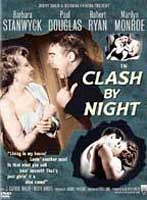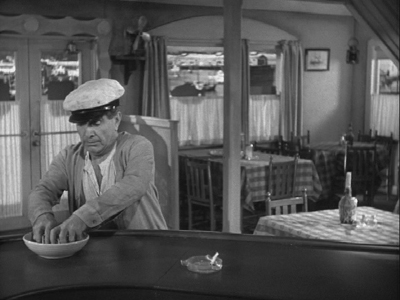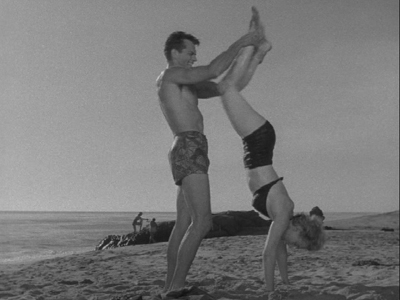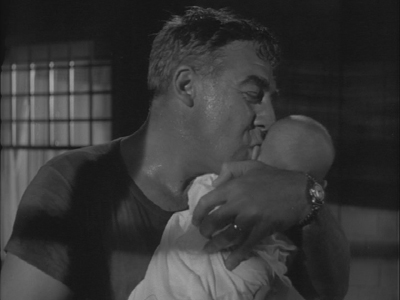 BUY IT
BUY IT
AT AMAZON: CLICK HERE!
STUDIO: Warner Bros.
MSRP: $19.97
RATED: Unrated
RUNNING TIME: 105 mins.
SPECIAL
FEATURES:
• Commentary w/ filmmaker Peter Bogdanovish/Audio excerpt from Fritz Lang
• Theatrical Trailer
The
fifties were a good decade for noir. The public called for irony in their
protagonists, wounded men and women who nevertheless were able to stand up for
themselves, even if it didn’t gain them much. In 1952, Fritz Lang (Metropolis,
M) directed Clash by Night, a film with the stylistic trappings of the noir
he was deft at but none of the conventions of story. Lang’s individual style is
what makes Clash by Night worth watching, but even his formidable talents
can’t bring the story above much more than a sentimental melodrama.
Barbara
Stanwyck plays Mae Doyle, a woman who has been away from her hometown for ten
years but now has decided to come back. She is reluctant to speak of her life
over the last decade except to say that she made a lot of mistakes and doesn’t
particularly wish to make them again. Stanwyck plays her a bit like a medicated
Katherine Hepburn, witty but laconic; the impression is that cynicism and
sarcasm have set themselves up right behind Mae’s face.

It was such a low-budget production that bit players were
forced into lives of thievery, just so they could eat.
Cynicism
and sarcasm are, to some degree, tools of independence. They are distancing
reactions, employed by the free-spirited to keep the world at a safe distance.
Surrounding Mae reintroduction into the small culture of her old town is a raft
of proto-feminist philosophy. The men are loud-mouthed caricatures, violent and
self-important, so Mae’s retreat into knee-cutting one-liners is natural
enough. Such exaggerations of character so early in the film, though, are
disheartening, and the moment that Mae meets the one decent man in town, Jerry
D’amato (Paul Douglas), the whole arc of the story becomes apparent: bad girl
meets nice guy, bad girl grows bored of nice guy, bad girl learns important
lesson. I chided myself during my viewing for being so simplistic, but I
forgave myself by the end.
The story
is a melodrama, meaning that it is designed to draw interest to the
interactions between the characters rather than to the characters themselves.
Originally written for the stage, there are significant sections of dialogue
that don’t lend themselves well to the screen, most notably in scenarios in
which the actors’ emotional expressions can be seen and still they go to
lengths to describe their emotional states. Stanwyck and Douglas both do a fair
job of delivering both the dead and lively lines, but in melodrama there are
rapid tone shifts required of actors, and here and there even the leads miss a
couple of beats between "reasonably content" and "raging
angry".

Those crazy Californians.
Clash by Night was one of Fritz Lang’s American
pictures, made for RKO Radio Pictures. It’s safe to say that Lang was a master
of noir styling, and his background using the dark eye contributes an
interesting look to this film. It’s not a typical noir in that it doesn’t
follow any of the crime/women/weight of the world conventions of that genre.
It’s a domestic drama, but Lang’s direction gives it a suitably dark, shadowed
look. There aren’t a lot of tricks to the camera work; it’s usually stationary,
and the shots are framed always around the characters rather than the
landscape. There is a repeating visual motif of the ocean to support the
development of the characters. Other than those exceptions, it feels a little
too close to its stage origins.
The
progression of the story might get frustrating to a viewer who gets attached to
the characters rather than the situations. The screenplay dispenses with large
swathes of time in order to accelerate the infidelity plot. Mae’s shifts from
sarcastic independent to devoted wife to disillusioned wife come too suddenly.
Her relationship with Earl (Robert Ryan) flips from love/hate to an ostensible
love affair with minimum involvement on the part of the actors (though they are
nicely supplanted by a shot of a turgid ocean). The unconvincing affection
between these two could be partly attributed to Ryan’s stilted delivery, flat
lines, and inability (or lack of opportunity) to play anything other than the
irresponsible cur.
The
philosophy behind the drama is a little slippery, with the abovementioned
feminism gradually fading and resurging throughout the script. Mae might be a
poster girl of independent women of the fifties in the first act, but by the
third she is just confused and, almost to an insulting degree, cowed by the
thought of not having a man to be with. By the last scene, where Mae is
desperate to recover her baby because it’s her symbol of stability, the film
seems to suggest that it was written by someone who had only a passing
acquaintance with women. The demonized males throughout the first two acts end
up as jilted lovers, hurt puppy dogs, with only a fraction of their original
bite.

Lang even tried to pay his leads in Monopoly money.
It’s a wonder the film ever wrapped.
This
leveling of the characters, bringing them all to a place where they express the
same emotions with the same degree of fervency, makes for an oddly satisfying
ending, despite the grating philosophy. Some of them travel up, some slip down,
but they all end up on even ground. The problem is that even ground is kind of
boring.
Oh, and
Marilyn Monroe had her first above-the-line billing in Clash by Night, and she’s
pretty much useless.
5.8 out of 10
The Look
The film
is fullscreen, as it was originally presented. The quality of the film used for
the transfer is a bit low; there are occasional scratches and clouds of dust
specks. As you’d expect from a noirish film, there are plenty of lights and
shadows in play during the dramatic scenes. These scenes are the ones that end
up looking the best, because the contrast is really cranked up. For exposition
scenes, many of which take place in daylight against neutral backdrops, the
actors have an annoying habit of becoming part of the scenery; there’s not a
lot to distinguish them from the walls or floor.
5.3 out of 10

"Now Daddy’s going to tell you a story. It’s called A Modest Proposal."
The Noise
Dolby 2.0
with no bells or whistles. The mix seemed muddy during the opening few minutes,
when a particularly fast-talking character had a paragraph of dialogue. Beyond
that, everything was clear. The incidental music might put some people on edge
because it’s so obviously manipulative, crashing with cymbals when something
terribly tragic occurs, whining with sad strings when a heart is about to be
opened and poured.
4.5 out of 10
The Goodies
fascinating commentary by filmmaker Peter Bogdanovich runs most of the feature
length, though he’s not often in a rush to spill out his ideas. Occasionally
the commentary is interrupted by excerpts from an audio interview Bogdanovich
conducted with Lang in 1965. These little nuggets Fritz Lang comment on the
film specifically and also on the broader topic of his period of working for
American studios. It’s an informative commentary, drier than most, but
fascinating for those interested in Lang’s history as a filmmaker.
There is also
the original theatrical trailer, which is of the design that triggers nostalgia
even in those folks whose parents weren’t even born when Clash by Night first
screened.
6.0 out of 10

"If you can say it to me, you can say it to Mister Winkums."
The Artwork
This is
wretched cover art. Three badly colorized stills from the movie arranged
haphazardly on what looks to be a Photoshop-generated pattern of difference
clouds. The title is in a font that could conceivably be mistaken as
"classic". Why not just any of the original promotional materials if
you want a classic look? This is just tacky and unattractive.
0.1 out of 10
As a DVD
package, Clash by Night is entirely unspectacular, not having much in
the way of additional material from the archives to include, and for the most
part Warners have done a decent job with what they had around. As a film, it’s
an interesting note in Lang’s filmography, but underwhelming in terms of
character and drama.
Overall 5.0 out of 10